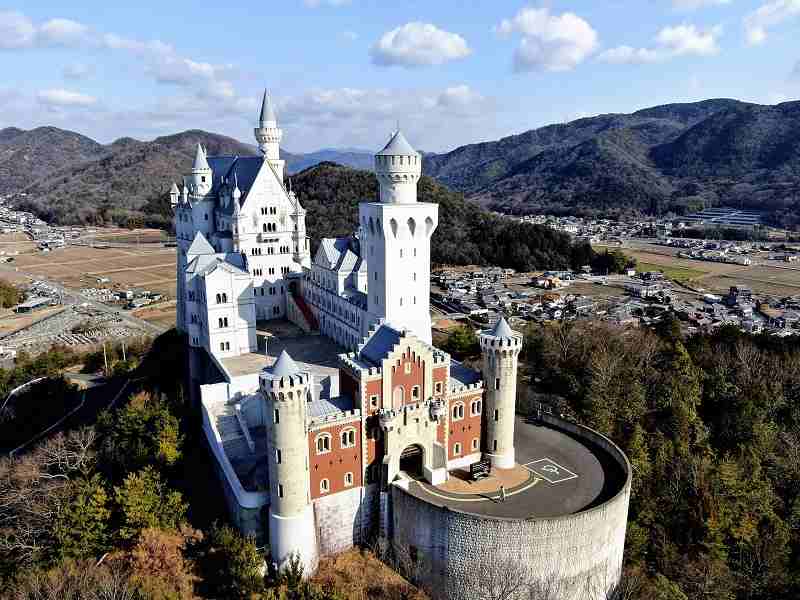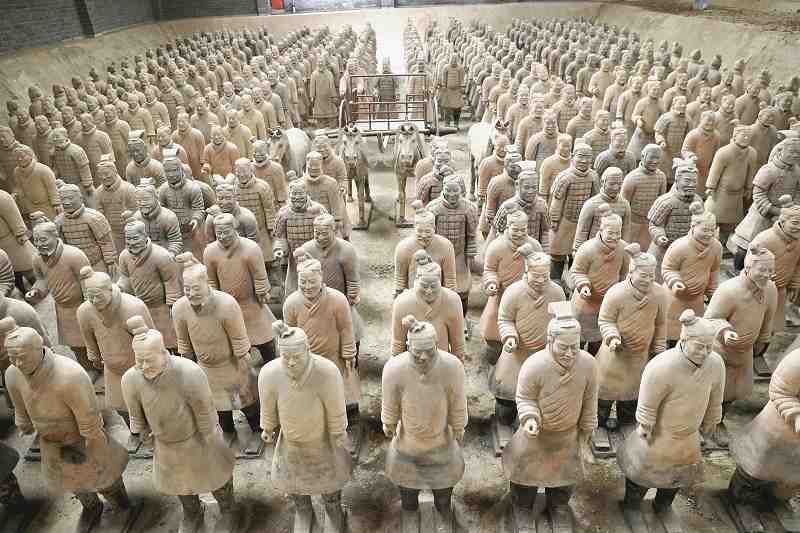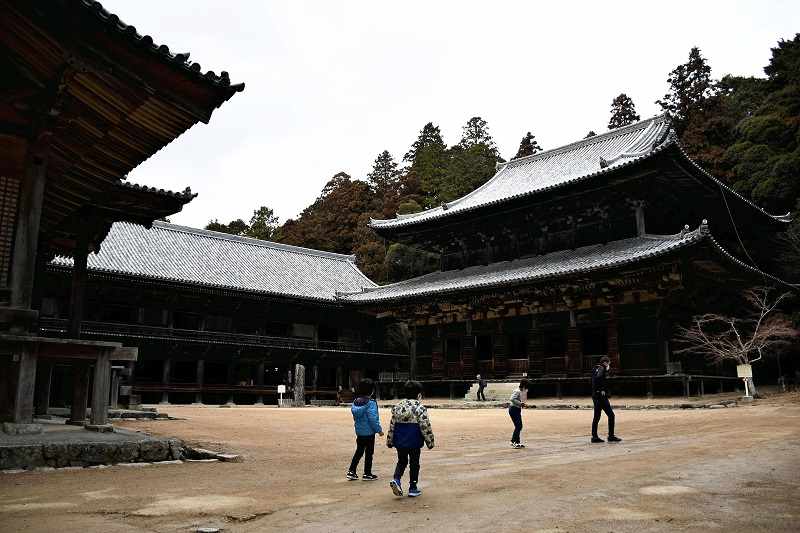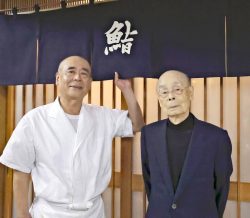
Taiyo Park’s Swan Castle, the park’s symbol, is seen in Himeji, Hyogo Prefecture. It was modeled after Neuschwanstein Castle in Germany.
18:22 JST, March 12, 2021
HIMEJI, Hyogo — While many come to visit Himeji Castle, a popular UNESCO World Heritage site in Himeji, Hyogo Prefecture, it isn’t the only tourist attraction the city has to offer.
At Taiyo Park, a local theme park, visitors can experience a trip “around the world” in the span of just two hours.
When visitors pass through the park’s re-created Arc de Triomphe, moai statues, just a tad taller than average human height, come into view. Further on, an army of 1,000 terracotta warrior statues, the likes of which can be spotted at tourist attractions in China, are also on full display. These are just a few of the park’s exhibits.
However, these doppelganger displays should not be discounted as mere replicas, as each exhibit was made with almost the same level of energy and precision as the original landmarks. Moreover, they carry with them the spirit of a man who dedicated his life to the welfare of others.
Landmarks from 20 countries
Taiyo Park, or Sun Park, is located in the Himeji countryside, about 9 kilometers northwest of Himeji Castle.
“We often hear visitors say things like, ‘[If such amazing things can be built] anything is possible’ or ‘What an amazing theme park,’” said Masaaki Kawasaki, 43, the park’s director.
And it’s no wonder. The park’s Arc de Triomphe stands 15 meters high, just short of a third of the Parisian landmark’s height, while the terracotta warrior statues stand as tall as the originals, with each of them bearing a unique expression.
Although the park’s Great Wall of China only measures about 2 kilometers long, far shorter than the real one, its path and walls were made in line with the original’s measurements. About 70 tourist attractions in 20 countries, reproduced with materials including stone and unglazed earthenware, are packed in a site with an area four times as large as the nearby Koshien Stadium.
“The meticulous details are amazing,” said a visitor from Himeji who brought along his family back in late January. He recalled his time seeing the real Arc de Triomphe in Paris up close and personal, saying, “I don’t feel that there’s anything lacking, even when comparing it with the real thing.”
Workplace for the handicapped
The park was established in 1992 by Kenzo Monguchi, founder of the social welfare corporation Taiyo Fukushi Group, which operates more than 30 welfare facilities, mainly in Himeji. Monguchi, who died in 2015 at the age of 88, came up with the idea of the theme park so that “people with disabilities and the elderly can get a taste of traveling the world.”
Monguchi had the terracotta warrior statues made in China, where the originals can be found in the Mausoleum of the First Qin Emperor, using the same materials to give them an authentic and powerful aesthetic. He also invited technicians from China to re-create Tiananmen Square.
The park’s most magnificent attraction is probably the 45-meter-high, seven-storied Swan Castle (called Hakucho-jo in Japanese), which was designed based on Germany’s Neuschwanstein Castle. Monguchi himself visited the German castle many times and obtained its blueprints prior to the construction of his castle, which was completed in 2009 atop a mountain roughly 110 meters above sea level. The total construction cost was about ¥4 billion.
Being operated by a social welfare corporation also allows this theme park to offer a unique service: Inviting disabled people under the care of the corporation’s welfare facilities to work cleaning the park and selling souvenirs to help them become independent. There were recently about 50 disabled people working on the premises every day.
“They all look lively and feel the joy of working thanks to interacting with visitors,” Kohei Yano, 46, a vocational instructor, said with a smile.

Replicas of China’s terracotta warrior statues are seen, each bearing a unique expression.
Instagrammable cosplaying
More and more young people come to the park to take photos that are Instagrammable. There are also many people who enjoy cosplaying as characters from anime and video games. These people post photos taken at the park on social media, which in turn, draws in more people.
A log house on the park’s premises was renovated to provide a convenient space for groups of visitors to change clothes. Areas where visitors can take commemorative photos featuring themes from popular anime and video games have also been prepared. The park has even recently received inquiries from the film and TV industries as shooting on location overseas has become nearly impossible amid the coronavirus pandemic.
“The fantastical appearance of the castle looks great alongside the costumes of video game characters,” said a university student visiting from Kyoto for the second time. “This is the only place I can take these kinds of pictures.”
The park’s original objective of empowering the disabled has not changed. Welfare facilities are dotted throughout the park grounds so that visitors can exchange greetings with residents of these facilities.
Taiyo Park is a mysterious place where the ordinary and the extraordinary come together, which may be the most attractive aspect of the theme park where “anything is possible.”
Extend your trip!

Engyoji temple
Engyoji temple is located at the top of Mt. Shosha, which stands 371 meters above sea level. The temple belongs to the Tendai sect of Buddhism and was used as a filming location for the movie “The Last Samurai” and NHK’s period drama “Gunshi Kanbei” (Strategist Kanbei). Visitors cannot reach the gate by car and need to either walk or use the ropeway. The entrance fee is ¥500.
Related Tags
"Features" POPULAR ARTICLE
-

Sanrio to Open Museum in Yamanashi Pref. Dedicated to Founder, Exhibits Include Hello Kitty, Other Characters
-

Legendary Sushi Chef Jiro Ono Turns 100: ‘I Have No Regrets’
-

Autumn Foliage Surrounds Visitors to Tokyo’s Showa Kinen Park
-

My Daughter No Longer Speaks to Me, But I Want to See Her and My Grandchild
-

Kumamoto: Public Bath Refurbished as Library Where You Can Chat, Take Photos
JN ACCESS RANKING
-

Keidanren Chairman Yoshinobu Tsutsui Visits Kashiwazaki-Kariwa Nuclear Power Plant; Inspects New Emergency Safety System
-

Imports of Rare Earths from China Facing Delays, May Be Caused by Deterioration of Japan-China Relations
-

University of Tokyo Professor Discusses Japanese Economic Security in Interview Ahead of Forum
-

Japan Pulls out of Vietnam Nuclear Project, Complicating Hanoi’s Power Plans
-

Govt Aims to Expand NISA Program Lineup, Abolish Age Restriction

























